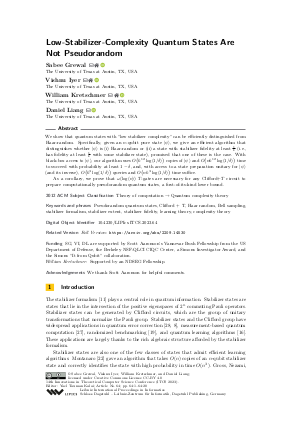@InProceedings{grewal_et_al:LIPIcs.ITCS.2023.64,
author = {Grewal, Sabee and Iyer, Vishnu and Kretschmer, William and Liang, Daniel},
title = {{Low-Stabilizer-Complexity Quantum States Are Not Pseudorandom}},
booktitle = {14th Innovations in Theoretical Computer Science Conference (ITCS 2023)},
pages = {64:1--64:20},
series = {Leibniz International Proceedings in Informatics (LIPIcs)},
ISBN = {978-3-95977-263-1},
ISSN = {1868-8969},
year = {2023},
volume = {251},
editor = {Tauman Kalai, Yael},
publisher = {Schloss Dagstuhl -- Leibniz-Zentrum f{\"u}r Informatik},
address = {Dagstuhl, Germany},
URL = {https://drops.dagstuhl.de/entities/document/10.4230/LIPIcs.ITCS.2023.64},
URN = {urn:nbn:de:0030-drops-175670},
doi = {10.4230/LIPIcs.ITCS.2023.64},
annote = {Keywords: Pseudorandom quantum states, Clifford + T, Haar random, Bell sampling, stabilizer formalism, stabilizer extent, stabilizer fidelity, learning theory, complexity theory}
}

 Creative Commons Attribution 4.0 International license
Creative Commons Attribution 4.0 International license


